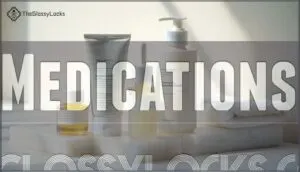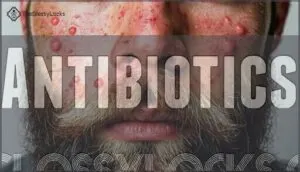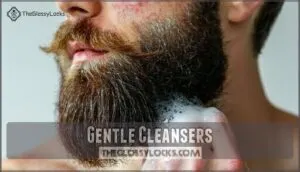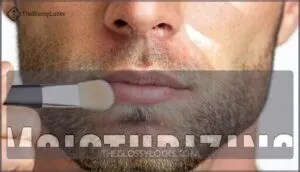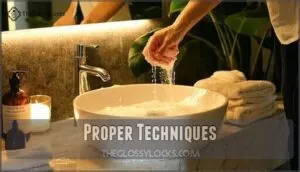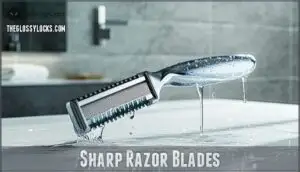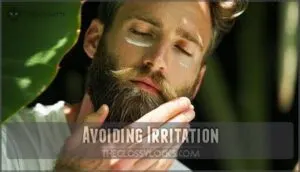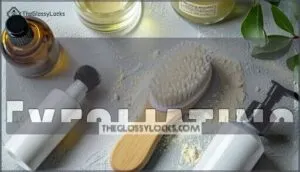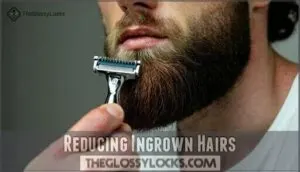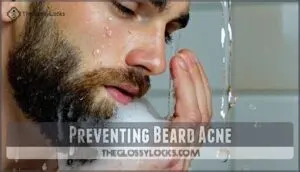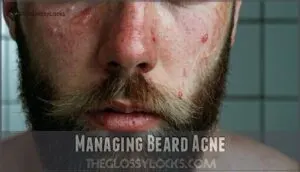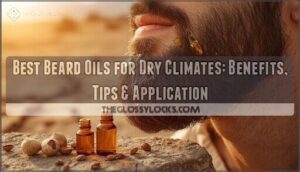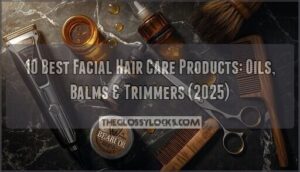This site is supported by our readers. We may earn a commission, at no cost to you, if you purchase through links.
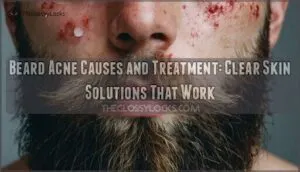
You’re dealing with trapped bacteria, dead skin cells, and oil that can’t escape through your thick beard coverage.
Poor hygiene, hormonal changes, and ingrown hairs from shaving make things worse.
To treat it, you’ll need gentle cleansers with salicylic acid, proper moisturizing, and sometimes antibiotics for severe cases.
Don’t skip washing your beard daily, and use a clean towel every time.
Sharp razor blades prevent irritation, while exfoliating removes dead skin.
The key is consistency with your routine, but there’s more to the puzzle than basic cleansing.
Proper moisturizing is essential to prevent dryness and irritation.
Table Of Contents
- Key Takeaways
- Beard Acne Causes
- Treating Beard Acne
- Shaving With Beard Acne
- Preventing Beard Acne
- Managing Beard Acne
- Frequently Asked Questions (FAQs)
- Why does my beard clog my pores & cause acne?
- Can beard acne be cured?
- Should you use beard oil if you have acne?
- What should I do if my beard is acne prone?
- Can sensitive skin cause beard acne?
- What causes pimples on a beard?
- Can beard acne cause permanent scarring?
- How long does beard acne take to heal?
- Are certain beard hair textures more acne-prone?
- Can trimming beard length reduce acne breakouts?
- Conclusion
Key Takeaways
- You’ll defeat beard acne by understanding it’s caused by trapped bacteria, oil, and dead skin cells beneath your facial hair – poor hygiene, hormonal changes, and ingrown hairs from improper shaving make breakouts worse.
- Your daily routine must include gentle cleansers with salicylic acid and proper moisturizing – wash your beard daily with lukewarm water, use non-comedogenic products, and don’t skip the moisturizer to prevent dryness and irritation.
- You can’t ignore proper shaving technique when dealing with beard acne – use sharp razor blades, shave with the grain (not against it), and incorporate gentle exfoliation twice weekly to remove dead skin cells and prevent ingrown hairs.
- You’ll need consistency and professional help for stubborn cases – stick to your skincare routine for 2-6 weeks to see results, and consult a dermatologist if over-the-counter treatments aren’t clearing your breakouts effectively.
Beard Acne Causes
Your beard might look great, but underneath, bacteria, oil, and dead skin cells can build up around hair follicles, creating the perfect conditions for acne breakouts.
Understanding what triggers these painful bumps, from ingrown hairs to hormonal changes, helps you tackle the problem at its source and keep your facial hair looking its best.
Bacteria Buildup
Within your beard’s cozy confines, bacteria buildup creates the perfect storm for beard acne.
Pillowcase bacteria transfers nightly, while scratching effects worsen inflammation by spreading germs.
Daily beard washing with salicylic cleansers removes oil and dirt that feed acne-causing bacteria.
Pre-bed washing prevents overnight bacterial growth, keeping your beard hygiene on point and your skin clear.
Ingrown Hairs
Ingrown hairs frequently plague men with curly hair, creating painful bumps beneath your beard.
When you shave against the grain, coarse hairs curl back into skin, causing pseudofolliculitis barbae.
Sharp razor blades and proper shaving direction help prevent this.
Regular exfoliation methods remove dead skin cells, while choosing single-blade razors reduces irritation.
Ingrown prevention starts with understanding your hair’s growth pattern and using the right techniques, such as regular exfoliation, to minimize issues.
Hormonal Imbalances
Your body’s hormonal roller coaster directly triggers beard acne through sebum overproduction.
During puberty fluctuations, androgens ramp up oil production, clogging follicles beneath facial hair.
Stress hormones from daily pressures worsen breakouts, while elevated insulin levels from poor diet choices fuel inflammation.
Unfortunately, genetic predisposition means some men naturally battle hormonal imbalances that make beard acne more persistent and stubborn.
Poor Hygiene
Neglecting your beard’s cleanliness creates the perfect storm for breakouts.
Poor hygiene allows bacteria to multiply, turning your facial hair into an acne breeding ground.
Here’s what’s sabotaging your skin:
- Dirty Pillowcases – Sleep on the same sheets for weeks
- Touching Beard constantly throughout the day
- Unclean Tools spread bacteria with every grooming session
Infrequent washing leaves product residue festering.
Sensitive Skin
Your sensitive skin might be fighting a losing battle against your beard.
When you’ve got delicate skin, even gentle friction from facial hair can trigger irritant reactions and redness. Your skin overreacts to normal beard maintenance, creating perfect conditions for beard acne to flourish.
| Sensitive Skin Triggers | Common Reactions | Beard Impact |
|---|---|---|
| Coarse hair texture | Redness and inflammation | Increased breakouts |
| Daily friction | Product sensitivity flare-ups | Clogged pores |
| Weather changes | Heightened irritation | Bacterial growth |
You’ll need gentle products with soothing ingredients for effective beard acne treatment.
Allergies
Sometimes your beard acne stems from allergies to shampoo allergens or skincare products.
Product sensitivities can trigger contact dermatitis, causing red bumps and itchy beard acne around your facial hair.
You’ll notice skin irritation that looks different from typical breakouts.
Identifying allergens through allergy testing helps pinpoint what’s causing your reactions, so you can avoid problematic ingredients and clear your skin, which is crucial for managing beard acne.
Treating Beard Acne
Once you’ve identified what’s causing your beard acne, you can start targeting those pesky bumps with proven treatment methods that actually work.
You’ll find relief through gentle cleansers, topical medications, proper moisturizing, and sometimes antibiotics for stubborn cases that won’t clear up on their own.
Medications
When bacteria and clogged pores won’t budge with basic skincare, it’s time to explore stronger options.
Your dermatologist can prescribe topical treatments like retinoids or oral medications to tackle stubborn beard acne effectively.
- Topical retinoids help unclog pores and reduce inflammation beneath your facial hair
- Benzoyl peroxide gels kill acne-causing bacteria while being gentler than harsh scrubs
- Prescription-strength salicylic acid penetrates deeper to clear blocked follicles
A good beard routine includes weekly exfoliation to prevent clogged pores.
Antibiotics
When topical treatments don’t cut it, your dermatologist might prescribe antibiotics for stubborn beard acne.
Oral antibiotics like tetracycline target bacterial infections beneath your whiskers, while topical antibiotics work on surface breakouts.
Treatment duration typically spans several months, though side effects remain minimal.
However, antibiotics manage symptoms rather than curing acne.
Antibiotic resistance concerns make combination therapy with other treatments increasingly important for long-term success.
Gentle Cleansers
Beyond antibiotics, choosing the right cleanser becomes your next line of defense against beard acne causes. A noncomedogenic cleanser with proper pH balance won’t strip your skin’s natural oils while fighting breakouts.
Look for beard wash products designed for sensitive skin, as regular soap can worsen irritation. Many find success using a specialized acne cleanser.
Key cleanser considerations for effective beard acne treatment:
- Ingredients Matter – Select cleansers with salicylic acid or glycolic acid that penetrate hair follicles without causing excessive dryness or inflammation.
- Cleanser Types – Choose specialized beard wash formulas over harsh facial cleansers, as they’re formulated to work with coarser facial hair.
- Application Methods – Gently massage cleanser into damp beard using circular motions, focusing on skin underneath rather than just the hair surface.
Moisturizing
Proper skin hydration acts like a protective shield against beard acne flare-ups.
You’ll want oil-free options that won’t clog pores while maintaining essential moisture balance. Nighttime routine application works best, allowing deeper penetration.
Sensitive skin responds well to gentle balm benefits over heavy beard oil. Choose non-comedogenic moisturizers that support both skin hydration and beard hydration without triggering breakouts, ensuring a good moisture balance.
Shaving With Beard Acne
When you’re dealing with beard acne, shaving becomes a tricky balancing act that requires careful technique and the right tools to avoid making breakouts worse.
You’ll need to adjust your shaving approach, use sharp blades, and focus on gentle methods that won’t irritate your already sensitive skin or create more ingrown hairs.
Proper Techniques
When dealing with beard acne, gentle shaving becomes your best defense against further irritation.
Follow the grain of your hair growth for proper shaving direction, avoiding aggressive strokes that worsen breakouts.
Apply products softly, use sterilized tools, and incorporate warm compress usage before shaving.
This careful beard care routine supports effective beard acne treatment while maintaining essential beard hygiene tips for clearer skin.
Using acne-appropriate products can further minimize irritation and flare-ups.
Sharp Razor Blades
Fresh blade material makes all the difference when tackling beard acne during your shaving routine.
Dull blades drag across skin, creating razor bumps and irritation that worsen breakouts. Multi-blade razors require proper razor maintenance—replace cartridges every five shaves for peak performance.
Sharp edges glide smoothly at the correct shaving angle, reducing friction. Using high-quality shaving tools can substantially improve your shaving experience.
Practice timely blade disposal to prevent bacterial buildup and maintain healthy skin beneath your beard.
Avoiding Irritation
Sharp blades matter, but avoiding irritation requires gentler approaches too.
Skip harsh soaps that strip your skin’s natural protection, making beard acne worse. Check product ingredients in your grooming routine for potential irritants.
Stop touching face throughout the day, as this transfers bacteria. Switch to hypoallergenic pillowcase material and avoid fabric softeners that might trigger beard folliculitis.
Prevention starts with gentle care. To further soothe the skin, consider using aloe vera gel after shaving to achieve natural protection.
Exfoliating
Gentle beard exfoliation removes dead skin cells that trap bacteria and cause beard acne.
Use a soft-bristled brush or mild exfoliant twice weekly—daily scrubbing irritates sensitive skin.
Choose chemical exfoliants over harsh physical scrubs for better results.
After exfoliating, apply non-comedogenic beard oil for post-exfoliation care.
Finding the right exfoliation frequency prevents breakouts while maintaining healthy skin underneath your facial hair.
Reducing Ingrown Hairs
Ingrown hair beard problems vanish when you master proper shaving techniques.
Always shave in the direction of hair growth, never against it.
Apply preshave oil to soften coarse whiskers, then use quality shaving cream for smooth glides.
Choose a sharp, single-blade razor type over multi-blade options.
Follow with gentle aftershave use to calm irritated skin and prevent bumps.
Preventing Beard Acne
Preventing beard acne starts with establishing daily habits that keep your facial hair clean, your skin healthy, and bacteria at bay.
You can stop breakouts before they begin by washing regularly, eating well, managing stress, and following simple grooming practices that work with your skin’s natural balance, which helps in maintaining a healthy skin and preventing acne.
Regular Washing
Daily beard washing stands as your first line of defense against beard acne.
Use lukewarm water with sulfate-free cleansers twice daily, focusing on washing frequency that removes oil without over-drying.
Different cleanser types work for various skin conditions, so choose non-comedogenic formulas.
Pat dry gently after washing, and rinse thoroughly to eliminate product residue that clogs pores.
Gentle Exfoliation
Beyond washing, you need proper exfoliation to prevent beard acne.
Removing dead skin cells prevents clogged pores beneath your facial hair, making this step essential for clear skin.
Exfoliation Methods for sensitive skin:
- Use chemical exfoliants like salicylic acid twice weekly instead of harsh physical exfoliants
- Apply beard exfoliant gently, avoiding over-scrubbing that worsens irritation
- Follow post-exfoliation care with moisturizer to maintain skin balance
Hydration
Proper hydration keeps your skin’s barrier strong and reduces acne flare-ups.
You’ll need both internal water intake and external moisturizing to see real results.
| Hydration Method | Key Ingredients | Application |
|---|---|---|
| Water Intake | Pure H2O | 8 glasses daily |
| Beard Oil | Jojoba, argan | Morning routine |
| Moisturizer | Hyaluronic acid | After cleansing |
| Hydration Routine | Combined approach | Twice daily |
This dual approach strengthens your skin barrier effectively.
Combatting beard acne also involves using essential oils like lavender.
Healthy Diet
Your fork wields surprising power against beard acne.
Processed foods and high sugar intake spike insulin levels, triggering inflammation and worsening acne causes. Smart dietary choices become your secret weapon for clearer skin beneath that beard.
Consider these acne treatment allies:
- Whole foods – fruits, vegetables, and lean proteins
- Low-glycemic options – oats, quinoa, and sweet potatoes
- Anti-inflammatory foods – fish, nuts, and leafy greens
Stress Management
High stress levels trigger hormone spikes that worsen acne breakouts under your beard.
When you’re stressed, your body pumps out cortisol and other stress hormones, ramping up oil production in those follicles.
This creates the perfect storm for clogged pores and painful pimples.
| Stress Management Strategy | Time Required | Acne Benefits |
|---|---|---|
| Meditation Techniques | 10-15 minutes daily | Reduces cortisol levels |
| Regular Exercise Benefits | 30 minutes, 3x weekly | Improves circulation, balances hormones |
| Quality Sleep | 7-9 hours nightly | Supports skin repair processes |
| Deep Breathing | 5 minutes as needed | Instantly lowers stress hormones |
| Balanced Lifestyle Activities | Varies | Prevents chronic stress buildup |
Managing stress isn’t just good for your mind—it’s acne treatment that works from the inside out.
Simple meditation techniques, even five minutes of deep breathing, can lower those troublesome stress hormones.
Regular exercise benefits extend beyond fitness; it naturally balances your system and improves sleep quality.
A balanced lifestyle approach tackles acne causes at their root.
When you’re constantly wound up, your skin pays the price through increased breakouts.
Think of stress management as preventive medicine for your beard area.
Managing Beard Acne
You can’t ignore beard acne once it appears, but you can control it with the right daily habits and skincare routine.
Managing existing breakouts requires consistent care, proper cleansing techniques, and sometimes professional guidance to prevent scarring and future flare-ups.
Using Beard Brushes
A quality beard brush becomes your secret weapon against acne breakouts.
Boar bristle brushes offer gentle exfoliation while distributing natural oils evenly throughout your facial hair.
The right bristle stiffness removes dead skin cells without irritation, promoting healthy beard hygiene.
Clean your brush weekly to prevent bacteria buildup.
Proper brushing technique involves downward strokes, supporting effective beard grooming and beard acne prevention.
Using the right brush can help manage beard brush acne.
Daily Skincare Routine
Since consistency beats intensity when battling beard acne, your daily skincare routine becomes your strongest defense.
Think of it as brushing your teeth – simple habits that compound over time for healthier skin beneath your beard.
- Morning routine: Start with gentle cleansing, apply lightweight moisturizer
- Evening routine: Remove daily buildup with beard wash, follow with beard oil
- Product selection: Choose non-comedogenic formulas designed for sensitive skin
- Routine consistency: Maintain same schedule daily for maximum beard acne prevention
Consulting Dermatologist
When your daily routine isn’t cutting it, a beard acne dermatologist becomes your best ally.
Professional advice helps identify underlying issues that over-the-counter products can’t touch.
Dermatologists assess severe acne, prescribe targeted acne medications, and recommend acne antibiotic treatments for stubborn skin conditions.
For severe cases, dermatologists might suggest topical retinoid treatments, known for preventing hair follicle plugging.
They’ll create a personalized professional treatment plan that actually works for your specific situation.
Maintaining Beard Hygiene
Good hygiene forms the foundation of clear skin beneath your beard. Consistent cleansing frequency and smart product selection help prevent breakouts before they start.
- Cleansing Frequency: Wash your beard with specialized beard shampoo 2-3 times weekly, avoiding daily washing that strips natural oils
- Product Selection: Choose gentle, non-comedogenic beard wash products designed specifically for facial hair
- Drying Methods: Pat dry thoroughly after cleansing to prevent bacterial growth in damp hair
- Tool Cleaning: Sanitize combs and brushes regularly, plus change pillowcases weekly for effective beard acne home remedies
Frequently Asked Questions (FAQs)
Why does my beard clog my pores & cause acne?
Where there’s smoke, there’s fire—your beard traps oil, dead skin cells, and bacteria against your face.
These particles clog pores beneath hair follicles, creating perfect conditions for acne breakouts and inflammation.
Can beard acne be cured?
You can’t permanently "cure" beard acne, but you can effectively manage and clear it up.
With proper hygiene, gentle cleansing, topical treatments, and consistent care, you’ll see significant improvement and prevent future breakouts, which helps in effectively dealing with the condition.
Should you use beard oil if you have acne?
Walking a tightrope between hydration and breakouts, you’ll want non-comedogenic beard oils specifically.
These won’t clog your pores like heavy oils do, keeping your skin moisturized while fighting acne beneath your beard effectively.
What should I do if my beard is acne prone?
Keep your beard clean with gentle, non-comedogenic cleansers twice daily.
Use lightweight moisturizers, avoid touching your face, and consider salicylic acid treatments.
If breakouts persist, consult a dermatologist for stronger solutions.
Can sensitive skin cause beard acne?
Your sensitive skin’s like a drama queen—it overreacts to everything.
Yes, sensitive skin can definitely trigger beard acne by reacting poorly to dirt, debris, harsh products, or improper shaving techniques, causing irritation and breakouts.
What causes pimples on a beard?
Pimples develop when your beard traps oil, dead skin cells, and bacteria against your face.
Poor hygiene, ingrown hairs, hormonal changes, and touching your beard frequently all contribute to clogged pores and breakouts.
Can beard acne cause permanent scarring?
Yes, beard acne can cause permanent scarring if you pick, squeeze, or scratch the pimples.
Deep cystic acne also increases scarring risk.
Proper treatment and avoiding touching breakouts helps prevent lasting marks.
How long does beard acne take to heal?
Beard acne typically takes 2-6 weeks to heal with consistent treatment.
You’ll see initial improvement within days, but complete clearing depends on severity, your skin type, and how well you stick to your skincare routine.
Are certain beard hair textures more acne-prone?
Like knights in armor facing different battles, curly and coarse hair textures trap more oil, dead skin, and bacteria against your skin.
They’re also more likely to curl back and create painful ingrown hairs.
Can trimming beard length reduce acne breakouts?
Trimming your beard to a shorter, manageable length can definitely reduce acne breakouts.
Shorter hair traps less oil, dirt, and bacteria against your skin, making it easier to cleanse thoroughly and prevent clogged pores, which is a key concept in reducing acne breakouts.
Conclusion
Remember, defeating beard acne isn’t rocket science, but it does require dedication. Understanding beard acne causes and treatment helps you tackle this frustrating issue head-on.
You’ll need consistent cleansing, proper moisturizing, and gentle exfoliation to keep your skin healthy beneath that facial hair.
Don’t forget sharp razors prevent irritation, while daily hygiene stops bacteria buildup. If problems persist, consult a dermatologist for personalized advice.
Your clear, comfortable skin is worth the effort you’ll invest.
- https://www.doctornicks.com/blogs/news/beard-acne-causes-prevention-and-treatment-tips
- https://www.proactiv.com/blog/treating-face-acne/how-to-get-rid-of-beard-acne
- https://brickellmensproducts.com/blogs/grooming-manual/how-to-treat-and-prevent-beard-acne
- https://www.yalemedicine.org/news/beard-mustache-skin-problems
- https://www.mayoclinic.org/diseases-conditions/folliculitis/symptoms-causes/syc-20361634

